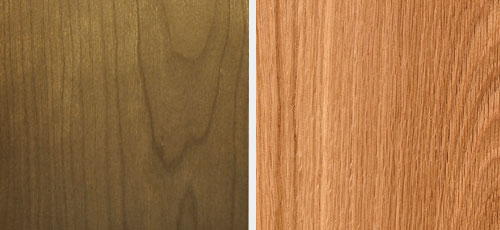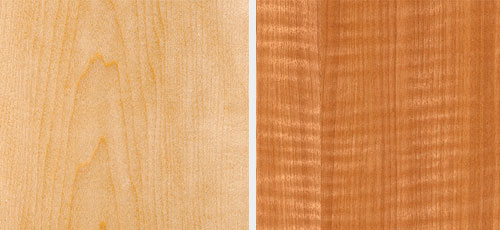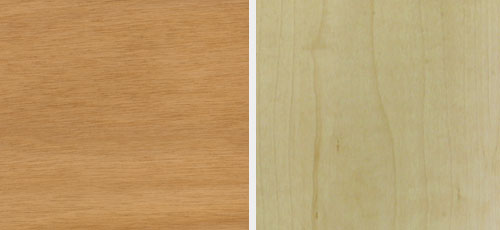Form Follows Fun: Design Options in Modern Ceiling and Wall Systems
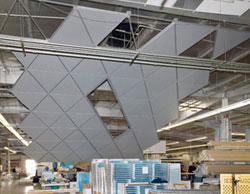 |
Mock-ups can help visualize tessellated designs and refine details. This mock-up for the New Doha International Airport indicates the large scale of the triangular aluminum panels and rhombic reveals. Photo courtesy Ceilings Plus |
A Tessellation Case Study -
The New Doha International Airport
The New Doha International Airport in Qatar, designed by HOK, San Francisco, demonstrates the architectural potential of tessellations. The main concourse has a wide-span, undulating ceiling vault. Its ceiling is assembled of triangular panels with edges as long as 4 ft. To better match the large scale of the concourse, the triangles are overlain with a rhombic pattern created by using wider joint spacing around clusters of eight triangular panels. A third visual element introduces rhythm by placing trapezoidal openings beneath skylights that allow filtered light to cast dappled shadows onto the floor below. The light weight of aluminum panels was important to the design, both because of the overall load on the long spans of the ceiling, and for access above the ceiling. The panels are also perforated for noise reduction, required because of the widespread use of hard, sound-reflective surfaces in the building.
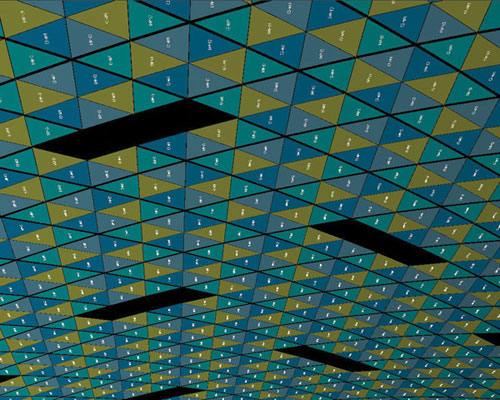 |
View of BIM of Doha Airport ceiling shows how triangular panels are grouped to form rhombic pattern more in scale with the large, vaulted terminal. Parallelograms indicate locations of skylights. Photo courtesy Ceilings Plus |
The Power of Polygons
The building blocks of tessellations are multi-sided shapes called polygons. In "regular polygons" such as equilateral triangles, squares, pentagons, hexagons, and octagons, all the edges are the same length, and all the angles between adjacent edges are equal. There are three "regular" tessellations that can fill a surface with just a single type of regular polygon - equilateral triangles, squares, and hexagons.
There are also eight "semi-regular" tessellations in which two or more types of regular polygons can be arranged so the configuration of polygons meeting at each vertex is the same. Further, there are 20 "demi-regular" tessellations that are more complex, yet can be formed from regular polygons.
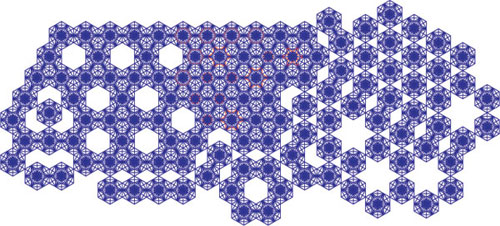 |
Freedom from the rectangular grid allows greater design freedom to vary the look and feel of a ceiling or wall in response to variations in program requirements in different parts of a space. Wood wall and ceiling panels at Pitzer College, Claremont, CA auditorium are lightweight and perforated to provide acoustical control. Design by Jiwon Hong. |
Many of these tessellations can be altered by elongation or skewing. For example, a tessellation of regular hexagons can be deformed by changing the length of one set of parallel edges, while a pattern of squares can be skewed to create a field of rhombi.
Beyond these are the tessellations composed of "irregular" polygons including non-equilateral triangles, quadrilaterals (e.g. rhombi and trapezoids), and polygons with edge lengths that are not uniform.
| The New Wood |
Traditional wood ceilings use architectural veneers over cores of particle board, plywood, solid lumber, or fiberboard. The difficulties entailed in fabricating these materials have imposed severe practical limitations on design. The new generation of wood ceilings use the same real-wood veneers laminated to sheet aluminum. This innovation is made possible by new adhesives and by substrate treatments that modify the molecular texture of aluminum sheet to improve adhesion. As a result, wood ceilings can now be made using the same automated fabrication techniques as metal ceilings, and enjoy the same range of options. Wood veneers offer a wide range of appearances. Wood installations can be specified with plain sliced or rotary, quarter, or rift cut veneers. Leaves of veneer from these different cuts can be book, slip, or random matched, making possible many looks such as symmetrical patterns or stepping effects.
Ceiling manufacturers provide a variety of wood species to meet design choices. Many species can be obtained from sources that are FSC-certified to maintain the chain of custody, assuring that veneers come from sustainably-managed forests, a contributory factor for LEED certification points. In addition, veneers can be stained to achieve a more precise match to a design palette.
Sealants for wood panels have advanced. Wood/metal panels are available with UV-cured finish that makes them suitable for exterior applications. Wood/metal panels are not subject to the warping and twisting that often affects solid wood or wood-core products. This means metal/wood panels can be installed before HVAC conditions are stabilized, accelerating building completion.
Reconstituted wood veneers are made from rapidly-growing species. They offer more uniform color and grain, and enjoy all the same metal-forming versatility. The benefits of using these wood/metal composite products are many. Metal ceiling panels can weigh as little as 1 pound per square foot (psf) including the support members, and a wood/metal system still only weighs 2 psf, a load similar to a mineral-fiber ceiling. A traditional wood ceiling panel - on fire-rated particle board core - would weigh 3 psf for the panel alone, and require more substantial suspension hardware, bringing the total system weight to at least 5 psf. A 48-in x 96-in wood/metal panel weighs about 32 lbs and can be handled by a single worker, whereas the same size wood-core panel would weigh 96 lbs and require two or three workers to install. The light load of these systems also allows the use of wood ceilings in remodeling projects where an existing structure had previously supported a mineral-fiber ceiling, but might not support the added dead load of conventional wood panels. The modern lightweight systems reduce costs associated with labor in transportation and handling, too. Further, wood/metal systems offer advantages with respect to installation and accessibility. While conventional wood ceiling panels are usually fixed in place due to their weight, the types of products discussed in this article are light enough they can be installed with torsion springs that allow easier installation and convenient access above the ceiling. Fabrication of conventional wood panels in curved shapes is an expensive process that effectively limits their use. Special jigs must be made, the wood must be kerf-cut to achieve the proper contour, and special lamination processes used for veneering. Wood/metal systems, on the other hand, benefit from the economy of high-speed automated fabrication. The technological changes in fabrication have dramatically decreased the cost of making holes and increased the precision of acoustic control achievable. Drilling holes in conventional wood panels is slow, costly, only allows use of round and obround holes, and prevents close spacing. With aluminum cores, wood panels can be perforated at high speeds and with any perforation shape and pattern. Another important factor in deciding to use metal/wood hybrids is aluminum's non-combustibility. Since wood veneer can be almost paper-thin - generally 0.035 in. - building codes allow these systems even where Class A surface burning characteristics are required. Another benefit can be found in the fact aluminum - unlike many traditional wood cores - does not emit urea formaldehyde, a known carcinogen, or other VOCs. The wood veneers ceilings can be bonded to the aluminum core with adhesives and factory-applied ultraviolet (UV)-cured coatings that have no VOCs. Specifying panels with different colors or finishes creates additional effects. The interplay between exposed metal panels and wood veneered panels can be especially dramatic, creating visual tension between smoothness and grain, cool and warm materials - in some cases, this can create the illusion of three-dimensionality. Many of the benefits of wood panels can be achieved at an even lower cost with wood-grained, dimensionally-simulated finishes. Compared to wood veneers, these film laminates present more uniform color and grain. They are wear-resistant and suitable for exterior use. Many patterns are now available in PVC-free formulations. |
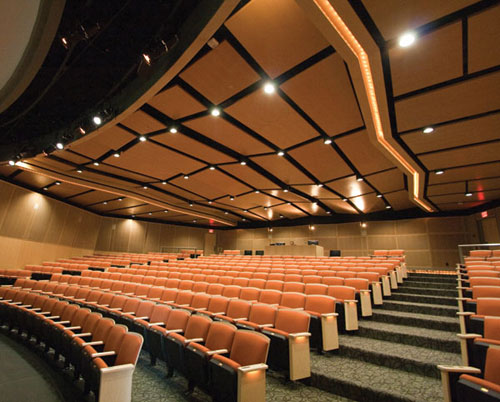 |
Wood wall and ceiling panels at Pitzer College, Claremont, CA auditorium are lightweight and perforated to provide acoustical control. Photo courtesy of Levin Associates |





